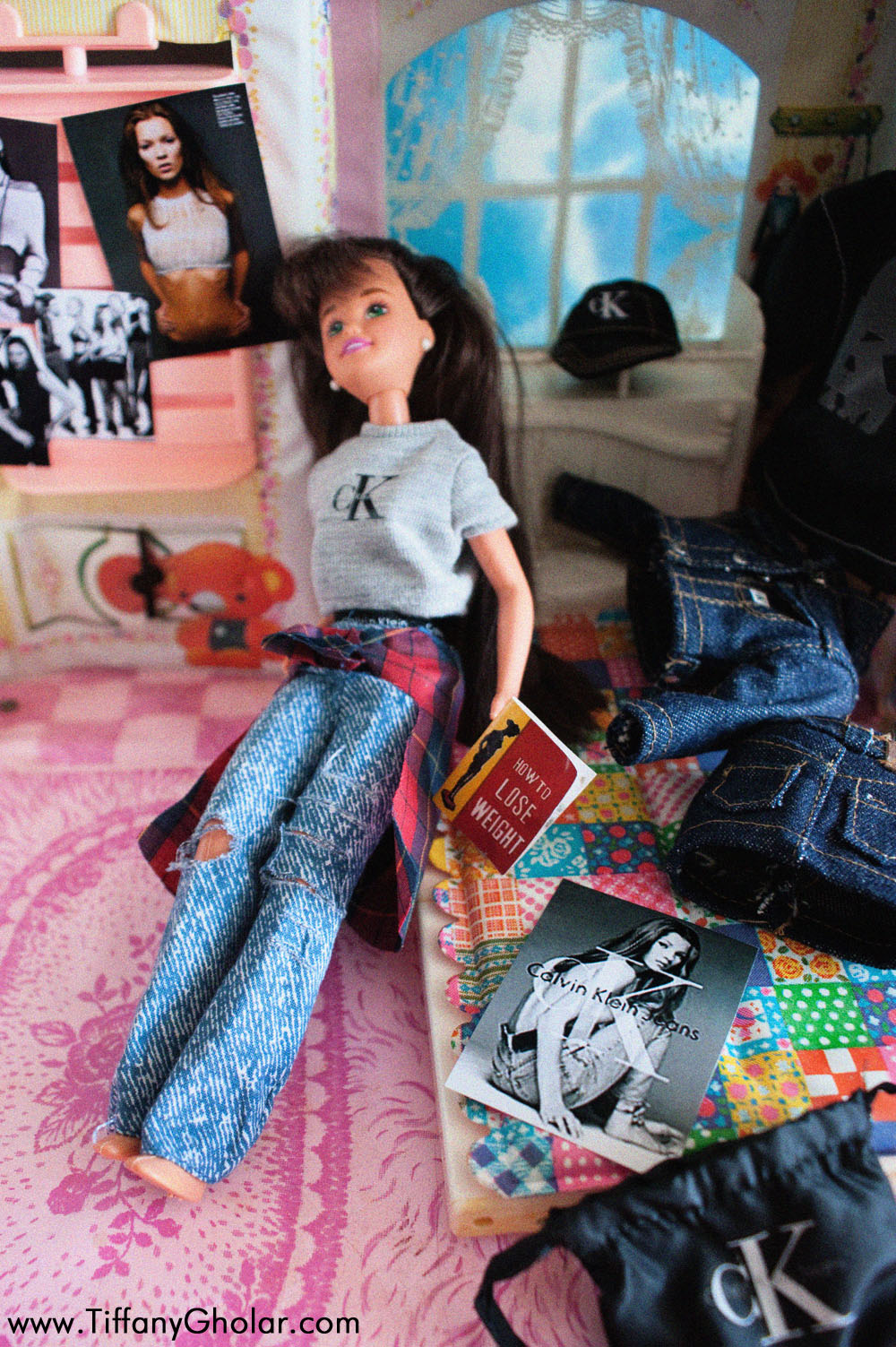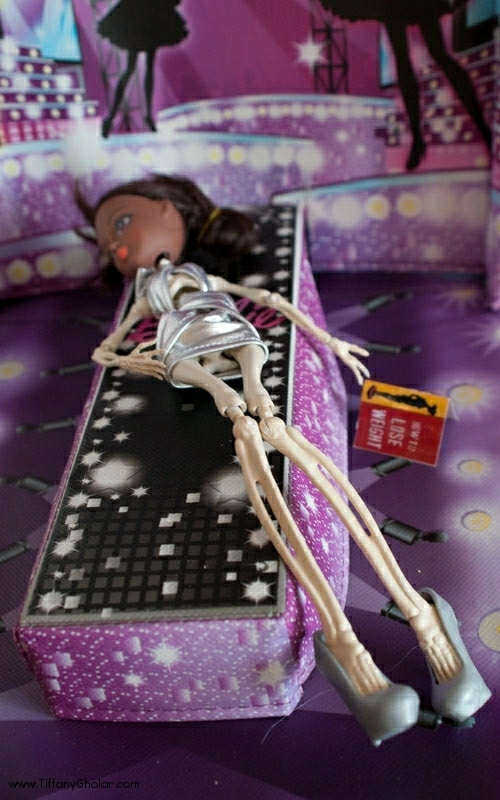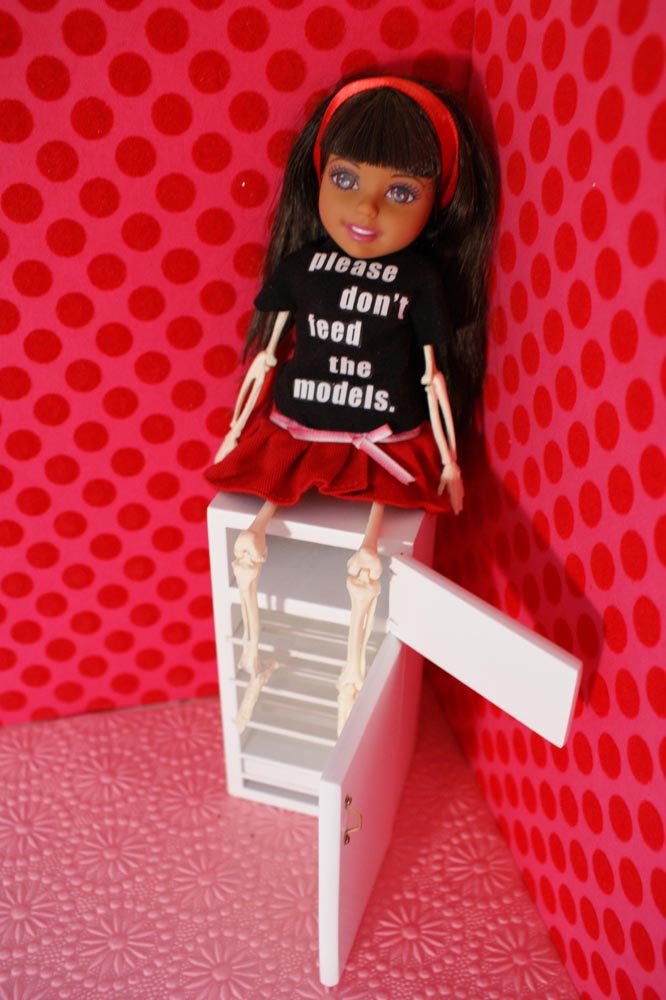At my latest open studio, a lot of people were asking me what I thought about Mattel's latest venture, putting Barbie in the 50th anniversary of the
Sports Illustrated Swimsuit Edition. I'm still trying to figure it out. For now, I feel ambivalent about it, as I do about a lot of the things Mattel does with Barbie.
The first Mattel controversy I remember surrounded Teen Talk Barbie. She had a lot to say and she voiced her opinions on various things, including her math class, which was tough. And she said so, too.
"Math class is tough!" Exclaimed the frustrated Barbies in their polka-dotted
Blossom hats.


I didn't play with Barbies anymore by the time these dolls came out,
but as a 12-year-old girl struggling with pre-algebra and algebra, I
could relate. My math classes were tough! I was in the gifted program.
Everything we did was difficult. And the math teacher I had at the time
didn't explain things in a way that I understood and I ended up needing a
tutor.
But all the adults on the news were freaking out
about what Barbie said and saying that she was stereotypical. Maybe
it was just my childish naivete or the fact that I spent my childhood
going to school with super-smart girls, but I didn't know there was a
stereotype about girls not being good at math. And that, as well as other news stories about girls and math, made me feel bad
because I genuinely felt that my math class was tough, and it made me
feel awkward about asking for help with it because now I was becoming a
stereotype. (And that's what they call a
stereotype threat.) Oddly enough, I ended up going to a
math and science high school. Unsurprisingly, Teen Talk Barbie was discontinued and has now become a rare collectors' item.
Mattel made another mistake a few years later when they released this doll, co-branded with a popular Nabisco cookie:
That's right, Oreo Barbie. Obvisously, they were completely oblivious to what the term (along with other snack-based racial insults like apple and Twinkie) means to people of color. And so another doll got pulled from the market and became a sought-after eBay commodity.
But I think the most unfortunate controversy--which shouldn't have been a controversy at all, in my opinion--was what happened when Barbie's best friend Midge got pregnant. Instead of welcoming the new addition and possibilities of a married doll with a little baby, a minivan, friendly neighbors, and Barbie as a pediatrician specializing in infants, the family values people were angry about pregnant Midge's very existence. So they got rid of her, her baby, her husband, her neighbors, her minivan, her pediatrician, her elderly parents, and their beautiful home. Yes, in the name of family values, they destroyed an entire family, and community. All because of a plastic baby bump with a tiny newborn inside.
 |
| Midge and her mom, the two most expensive dolls of The Doll Project |
Let me break this down another way: because of public outcry, (OMG! Now I have to tell my daughter where babies come from!) Mattel was forced to get rid of two dolls with the most realistic body types they ever made (and there were both Black and White versions), not to mention a diverse family (
Midge's neighbors were Asian) and a Barbie with a high-level position in the medical field. And so once again, they became a coveted eBay item amongst collectors. I still don't have Black Grandma Barbie yet and I am so frustrated. I need her for The Doll Project.
So how do I feel about the latest controversy? I guess the best way to break it down is to dissect the second half of my first sentence in this post: "putting Barbie in the 50th anniversary of the
Sports Illustrated Swimsuit Edition." Barbie is, you might remember from a
previous post about self-objectification and fashion dolls, a clone of a doll based on a pinup girl comic strip character in a German men's magazine from the 50's. Her name was Lilli.
And now, in some ways, it seems like Barbara Millicent Roberts is getting back to her roots. She made her debut in a black and white striped bathing suit, a one piece that offers about as much coverage as the one she's wearing in
Sports Illustrated. Because Barbie was so sexy, Mattel created Midge as the girl-next-door (whatever that means) best friend with freckles who wore less makeup. I read somewhere that by doing so, the company made it easier for mothers to buy the dolls for their daughters. Midge made the prospect of fashion dolls less threatening.
Which brings me to thoughts of the various waves of feminism. Should Barbie be condemned for being sexy? Should real women? Should we be forced to cover ourselves up because our bodies are too distracting? Does wearing makeup mean that we shouldn't be taken seriously? Does being interested in fashion make us shallow? Is it really so terrible to be considered beautiful? Is it wrong to get paid for it as a fashion model or to pose in a swimsuit? Must we all submit to the strictures of those who would have us all dress in shapeless clothing and not wear any jewelry or cosmetics? The academics who push for this sort of thing seem no better than adherents of various faiths who seem to believe in a sort of divine frumpiness, including some of the older members of the strict church I grew up in.
One
commenter seemed upset with what I wrote about in my post about fashion dolls and self-objectification, and I felt bad about it. I was worried I may have come across as "slut-shaming" when really, that wasn't my intent. And I almost feel like I detect a hint of that in the latest Barbie controversy. I mean, it is a one piece bathing suit, after all. Not that wearing a bikini makes a woman a lesser human being, but what Barbie is wearing is what most people would call "tasteful," I think.
I think a big part of the real reason so many people are so upset about what Mattel has done has to do with how real women are portrayed in the media. If being a swimsuit model were just one of many roles women play in mainstream media, perhaps Barbie's
Sports Illustrated appearance wouldn't be so big of an issue. But it isn't. And not only that, but it seems that in our society people cannot fathom the idea that a woman could be both conventionally attractive and accomplished. Beautiful women are often portrayed as stupid; smart women are often portrayed as unattractive. Notice how people's heads nearly explode at the revelation that certain glamorous women throughout history were also
well-read,
knowledgeable in mathematics or hard sciences, or
majored in difficult subjects in college. Documentaries like
Miss Representation have compiled a great deal of statistical information on the subject and it's definitely worth viewing in light of this current conflict.
But Barbie's appearance in
Sports Illustrated also seems like a conceptual art piece to me, exploring the idea of the simulacrum. Simulacrum is a concept of post-modernism. It is a word for the phenomenon in which the copy of something is so close to the original that the original is no longer important. In some ways, Barbie is the simulacrum of the overly-Photoshopped fashion model. Her hair doesn't need to be bleached because it is already blonde, her teeth are already whitened, her face is perfectly symmetrical, and her eyes are disproportionately large. Her skin tone is perfectly even, and her body is the type modeling agencies are looking for. With the exception of her full head of hair (which never gets split ends) she is hairless. Her facial expression is molded into a smile. Her cosmetics are permanently painted on. So she doesn't need any Photoshopping. And because she is only 11.5 inches tall, dressing her doesn't require the use of a great deal of fabric. So she is the perfect model.
I was watching another documentary I highly recommend called
America The Beautiful in which the director interviewed a fashion designer who claimed he needed the thinnest possible models so he wouldn't have to use so much expensive fabric for his designs. And I remember thinking, "then why don't you just use Barbies for your models?" And when I look at what Mattel did from that perspective, it almost seems satirical and brilliant. But this is a company that doesn't exactly have a track record of brilliance, so I know that's not what this is about.
It's about money, and the fact that I found out about Barbie's appearance in
Sports Illustrated not via one of the collector blogs I frequent but on a radio show about money (NPR's
Marketplace) is evidence of that. Bloomberg, Forbes, and the Wall Street Journal are all over this story. It's a marketing move, plain and simple. They did it to impress financial analysts who might now be persuaded to add some Mattel stock to more mutual funds and index funds. They did it to pacify stockholders who probably weren't happy with the company's earnings last quarter. They did it in blatant disregard for their main customers, parents buying toys for their daughters. Ignoring everything that parents or feminists might say, t
hey claim to be "unapologetic" about it.
And this isn't a toy that can be recalled from shelves. It's print and digital media that will be archived and reproduced. It will be remembered for a long time. In the interview I heard on
Marketplace, they mentioned some vague notion of brand awareness amongst the women who will read the Swimsuit Edition. It almost sounded like they were trying to attract collectors. But as a collector, I can tell you that it doesn't excite me at all. And I am sure that a lot of my fellow collectors would agree. From what I've gathered from collector blogs, most of us do want more from Mattel, but we want more articulation (meaning dolls that can bend their elbows, wrists, and knees), more diversity (how about having Latino and Asian Ken dolls available all the time?), more dolls with heads of normal proportions (instead of giant cartoon heads). But this? None of us asked for this.
When I was in college, I applied unsuccessfully for internships, and then later for jobs at Mattel. Every once in a while, I think, "See, they should have hired me." This is another one of those times. I could think of so many more ways they could have made Barbie more interesting without upsetting so many people. For example, instead of celebrating the 50th anniversary of the Swimsuit Edition, why not focus more on the
50th anniversary of Barbie's teenage sister Skipper, which is also this year? Why not reach out to children suffering with cancer and make some dolls who look like they've been through chemotherapy? People have been petitioning for years for that, but only Mattel's rival, MGA (maker of Bratz)
has actually done it. Ultimately, what Mattel has done is just another sleazy example of corporate greed, which, as an occupier, does not surprise me. More than anything, I feel disappointed.
I don't plan to stop collecting Barbie dolls because of this, though. But for those who are so inclined but don't want to give up the fashion doll habit altogether, and also for people looking for other dolls they could buy for their kids, check these out:
Prettie Girls
Kuhrn and Yue-Sai WaWa
Lottie Dolls
And as a final note, I wanted to add that as I near completion of The Doll Project, I have sometimes worried about what Mattel might do if they saw the way in which I have photographed their product. I was worried about being sued, as
some other artists have, for "compromising their brand integrity" or some such corporate nonsense. But after this, I don't think that's a legitimate argument anymore.






















